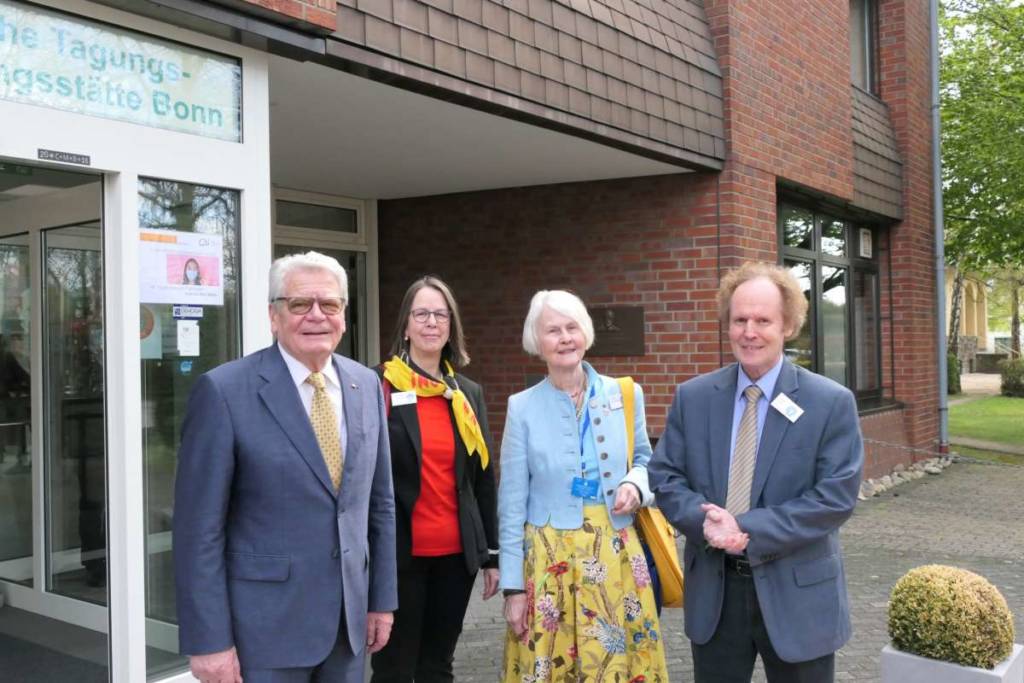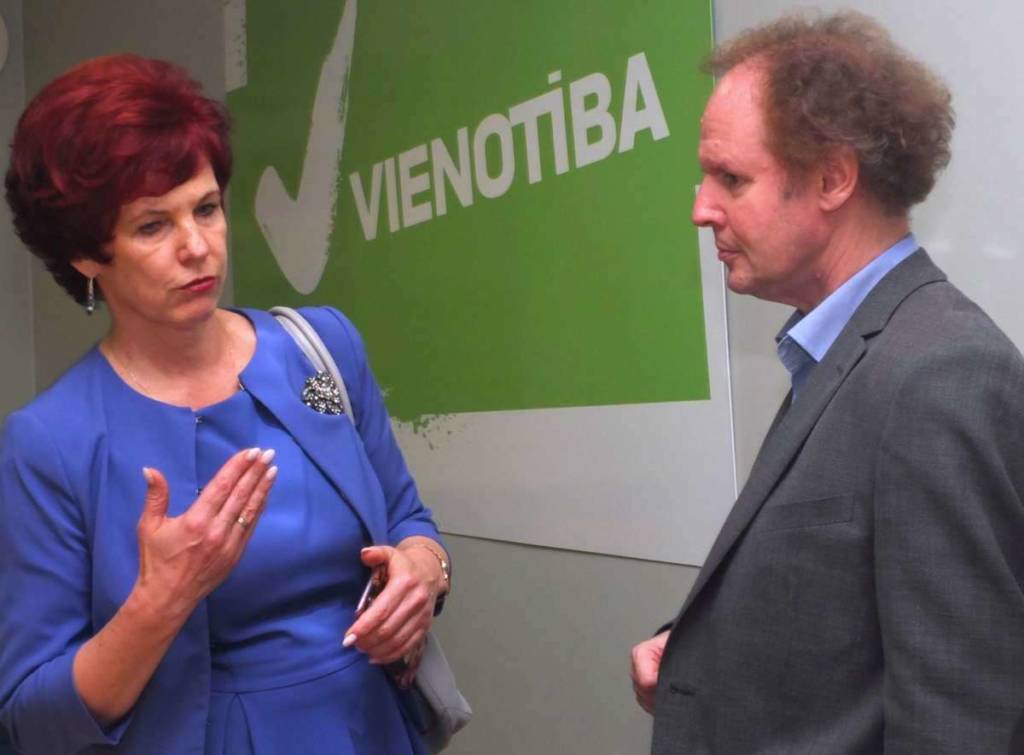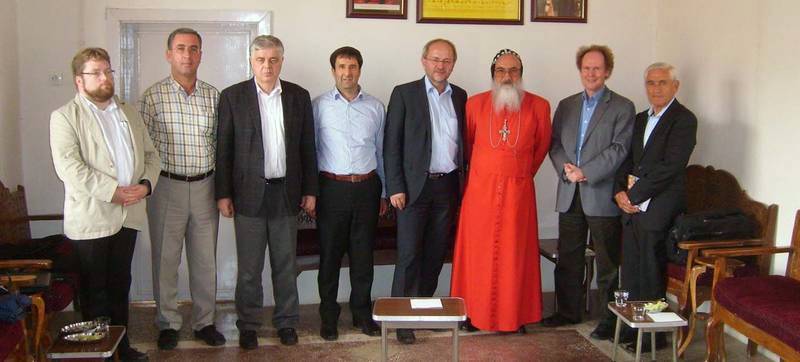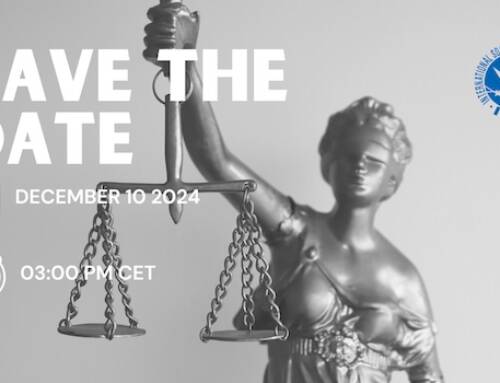SPEECH BY EDGAR LAMM

Welcome by IGFM Chairman Edgar Lamm to the 50th Annual Conference
Dear Mr. Federal President,
Dear Mr. Michael Brand, Member of Parliament,
Dear Ambassador Professor Shieh,
Dear Mr. Mayor Demirbas,
Dear Professor Ike,
Ladies and Gentlemen,
On 8 April 1972, the International Society for Human Rights was founded in Frankfurt am Main. at the height of the Cold War. The foundation was also a reaction to the trivialisation of human rights violations in the GDR and Eastern Europe. We still remember well how inopportune it seemed to many in the 1970s and 1980s to criticise the communist tyranny in the immediate vicinity. It was – in today’s words – politically incorrect to talk about it.
One can no longer imagine it today. But until 1988 – one year before the fall of the Wall – there were still efforts in the then Federal Republic to fulfil far-reaching demands of the SED:
Closure of the Central Registration Office in Salzgitter. GDR injustice, such as fatal shootings at the inner-German border, was documented there.
Recognition of a separate GDR citizenship.
Relocation of the inner-German border in Lower Saxony from the east bank of the Elbe to the middle of the river. This would have meant that refugees could be shot up to the middle of the river.
As we know, history fortunately took a different course. Communism in the GDR, Eastern Europe and the Soviet Union collapsed. The unjust state of the GDR dissolved completely. This state of injustice stood for the Wall, barbed wire, shoot-to-kill orders, automatic firing ranges, minefields, political prisoners, forced adoptions and forced labour. It stood for the Stasi and one-party dictatorship.
It is necessary to remember this again today! The GDR, that was the state with the unique criminal offence of “Republikflucht”. That says it all. According to the will of the people, it would have perished on 17 June 1953 – 4 years after the founding of the state. Only Soviet tanks could prevent that.
From the beginning, therefore, Eastern Europe and the former Soviet Union have been a focus of our work. We have had our own IGFM sections there for many years. Even after 1990, the IGFM considered it one of its tasks to inform people about the machinations of the defunct SED dictatorship. Especially since the IGFM itself was the subject of numerous so-called “operative measures” by the Stasi.

IGFM Chairman Edgar Lamm next to former Federal President Joachim Gauck, IGFM Honorary Chairman Katrin Bornmüller, IGFM Board Member Carmen Jondral-Schuler and other IGFM activists.
CSCE
An important field of action for us in the 1970s and 1980s was the CSCE process, which we actively accompanied.
As a reminder, the Conference on Security and Cooperation in Europe adopted the CSCE Final Act in Helsinki on 1 August 1975. In it there was the so-called Basket III on humanitarian affairs. All signatory states committed themselves to respecting human rights. The Eastern bloc states had also signed this. They probably regretted that later.
The CSCE process was dynamic, i.e. review conferences were held regularly. The IGFM regularly took part in these follow-up conferences and the special conferences on human rights issues: 1977 in Belgrade, 1980–1982 in Madrid, 1985 in Ottawa, 1986 in Berne, 1987 and 1988 in Vienna.
Before these conferences, the IGFM received thousands of petitions from victims of human rights violations or their relatives. We documented these and handed them over to the conference delegations on site. Accompanied by press conferences. Also in Belgrade, which was not so easy at the time. We did what NGOs do best: We created publicity. That’s how we still do it today.
The topics of our documentaries on the CSCE reflect the human rights discussion in Europe before the fall of communism in 1989 / 1990: Several Helsinki groups emerged in the Soviet Union from 1976 onwards, urging compliance with the CSCE Final Act. Their members, including prominent civil rights activists such as Alexander Ginsburg, Yuri Orlov and Anatoly Shcharansky, were subsequently arrested.
A largely forgotten chapter is the abuse of psychiatry in the Soviet Union for political purposes. On the occasion of our 50th anniversary, we recently produced a new edition of our documentation “Psychiatry as a Political Weapon”.

Welcoming of former Federal President Joachim Gauck by IGFM Honorary Chair Katrin Bornmüller (2nd from right), Chairman Edgar Lamm and Board Member Carmen Jondral-Schuler
Furthermore, the IGFM supported numerous Russian-Germans who had applied for emigration to the Federal Republic of Germany.
In Czechoslovakia, the human rights document “Charter 77” was created in 1977. Its signatories were subjected to reprisals or arrested, including Pavel Kohut, Vaclav Havel, Jiři Lederer and Vladimir Škutina. In Poland, members of the Solidarnosc trade union were persecuted. In Romania, members of the German minority were often prevented from leaving to join their relatives in the Federal Republic of Germany.
However, the IGFM received the most submissions on the GDR in the run-up to the CSCE follow-up conferences.
These were primarily about the persecution and arrest of those applying to leave the country. The commitment of courageous civil rights activists such as Dr Karl Heinz Nitschke, the initiator of the Riesa petition of 1976, was also highlighted. IGFM supported the petitioners at the time and publicised the petition in the West. It was an early “IGFM case”.
In 2016 – 40 years later – we created a permanent exhibition and documentation on this with the support of the Federal Foundation for the Reappraisal of the SED Dictatorship. The exhibition has found its place in the Cottbus Human Rights Centre, with which we cooperate closely. In total, more than 20,000 citizens of the GDR asked the IGFM for support in the period between the founding of the IGFM in 1972 and the fall of the Wall in 1989.
This was probably one of the reasons why we were declared “enemies of the state” by Stasi Minister Mielke and persecuted accordingly. We had to work hard for the title “enemy of the state”!
The IGFM made the following demands to the CSCE conferences:
- Lifting of the ban on emigration and permission for visiting trips to non-communist countries.
- Dismantling of the self-propelled guns and clearing of the minefields on the inner-German border
- Permission to purchase newspapers and literature from Western countries
- dissemination of the Universal Declaration of Human Rights and the CSCE Final Act in communist countries
- Lifting of work and occupational bans imposed on opposition members
- Ending the forced adoptions of children whose parents were imprisoned for political reasons or deported to the Federal Republic of Germany as part of the prisoner ransom programme.
- Guarantee of religious freedom
Just like today, there was a contentious debate at the time about whether international sporting events should be boycotted in dictatorships. 1980 was the first year of the Soviet occupation of Afghanistan – and it was to be the year of the Olympic Games in Moscow. The IGFM called for a boycott of the “Games of Peace” in the warring Soviet Union. In the 1980s, Poland suddenly took centre stage. The communist regime was challenged with the founding of the Solidarnosc trade union.
In 1981, the IGFM organised the parcel drive “From Person to Person”. In view of the constantly deteriorating supply situation in Poland, thousands of parcels were sent to private addresses in Poland.
We organised one of the biggest humanitarian aid campaigns in Germany for the trade union movement after the end of martial law from 1983. Almost weekly, working groups of the IGFM assembled truckloads of humanitarian aid. Our appeals for help were lively supported by Danuta and Lech Walesa. In the 1980s, IGFM work increasingly expanded geographically, with documentation on human rights abuses in Ethiopia, Nigeria, Guinea, China, Iran, the Philippines, Nicaragua and Cuba.
In 1987, Mikhail Gorbachev’s reform efforts in the Soviet Union slowly began to take effect. During the aforementioned CSCE follow-up conference in Vienna, Soviet television visited the Vienna office of the IGFM for two hours. The journalists filmed maps with details of penal camps and prisons and discussed in detail with the staff the abuse of psychiatry in the Soviet Union and the fate of the Soviet Helsinki groups. So much openness was unthinkable before.
It fits in with this that we were also able to found the first working group of the IGFM in St. Petersburg in 1987. 1987 was also the year of Erich Honecker’s visit to the Federal Republic. As is well known, there was no sign of reforms in the GDR. We therefore presented 2,600 petitions from GDR citizens to the Permanent Mission of the GDR in Bonn on 4 September 1987.
On the day of Honecker’s visit, an IGFM advertisement appeared in ten daily newspapers with a total circulation of 1.7 million, outlawing the order to shoot at the Wall and the inner-German border. This advertisement was financed by donations from a total of 1,300 people.

Former Federal President Joachim Gauck between Prof. Dr. Shieh, Jhy-Wey, the representative of Taiwan in the Federal Republic of Germany, and Michael Brand MdB, spokesman of the CDU/CSU parliamentary group in the Committee on Human Rights and Humanitarian Aid of the German Bundestag (left).
Then came the turnaround in 1989/1990.
The fall of the Wall and with it the Iron Curtain was a historic stroke of luck. Just imagine for a moment that the Red Army was still standing on the Elbe today. 350,000 soldiers, with civilian personnel half a million. Under the command of Putin. Just imagine it for 1 second and you quickly realise how grateful we can still be today.
Under no circumstances should the merits of the Eastern European peoples in overcoming communism be forgotten. We remember well that Hungary cut the first hole in the Iron Curtain in the summer of 1989. We also remember the courageous Poles who overcame communism in the 1980s.
Before the collapse of communism, our work focused on helping the politically persecuted, but since the beginning of the 1990s, humanitarian aid and development cooperation have been added as fields of activity.
The disappearance of the Iron Curtain also enabled us to found our own IGFM sections in Eastern Europe. Thus, sections were gradually established in Russia, Ukraine, Lithuania, Latvia, Armenia, Azerbaijan, Georgia, Moldova, Belarus, Romania and Albania. With some of them, we have been able to carry out programmes within the framework of the Eastern Partnership in recent years, thanks to the support of the Federal Foreign Office.
Humanitarian aid transports to the Baltic States and South Eastern Europe began. Projects became possible that were previously unthinkable. One example is our 1995 EU-funded project “Building a Civil Society in the CIS”. By the end of the project in 1996, more than 2,500 multipliers had taken part in 60 seminars and lectures in 15 cities in Russia and Ukraine.

IGFM Chairman Edgar Lamm in conversation with Latvian Christian Democrat parliamentary group leader Solvita Aboltina as part of an IGFM visit in 2016.
1997 – IGFM turns 25.
Country reports on China, Vietnam, North Korea, Pakistan, Turkey, Iraq, Saudi Arabia, Cuba, Congo, Egypt, Sudan, Nigeria appeared in the journal “Menschenrechte”. In 1998, in memory of the Pakistani Bishop John Joseph, the “Bishop Joseph Circle” was founded as part of the IGFM working area “Religious Freedom”, which deals with the worldwide persecution of Christians.
Religious freedom and the persecution of Christians has increasingly become one of IGFM’s main areas of work over the last 20 years. This is because more than half of the world’s population lives under regimes that disregard the right to free exercise of religion. For many years, together with the evangelical news agency IDEA, we have been calling out the Prisoner of the Month and asking readers to speak up for him.

IGFM Honorary Chair Katrin Bornmüller and IGFM Chairman Edgar Lamm presented a certificate of thanks to Mart-Olav Niklus during a visit to the Estonian capital Tallinn in 2017 in recognition of his great commitment to Estonian freedom and independence and his longstanding struggle for human rights.
People’s Republic of China
Today everyone is talking about China. As early as 1999, we published a highly acclaimed special publication “50 Years of China – 50 Years of Human Rights Violations”. Too much attention is paid to China. This led to a very strange and embarrassing event in 2017:
In March 2017, the city council of Trier had decided to accept an oversized statue of Karl Marx donated by the “People’s Republic” of China and to place it in the middle of the city. In a letter to the parliamentary groups in the Trier city council, we clearly criticised this decision. It was a poisoned gift. The proverb says: “You don’t look a gift horse in the mouth.” In this case, Trier should have made an exception and “looked China in the mouth”.
We are similarly critical of the Confucius Institutes – also in Germany. These are Chinese state propaganda institutions. They are not independent educational or cultural institutions, but function as political outposts of the communist party. They convey an embellished image of the People’s Republic of China abroad. They are Trojan horses. They are in no way a Chinese version of the Goethe Institutes.

Meeting of the IGFM delegation with the Archbishop of Tur Abdin and Abbot of Mor Gabriel Monastery in 2014. From left to right: Benjamin Lassiwe, journalist; Kuryakos Ergun, Chairman of the Monastery Foundation; Walter Flick, IGFM; Sabri Alkan; Volkmar Klein, MdB; Archbishop Timotheos Samuel Aktas; Edgar Lamm, Chairman of IGFM, Archdeacon Isa Gülten.
Turkey
2015 marked the 100th anniversary of the genocide of the Armenians and Assyrians in the then Ottoman Empire. We took this as an occasion for an exhibition and a publication under the title “Genocide 1915 and Threat 2015”. In doing so, we put the genocide of 1915 on a par with the crimes against humanity committed by IS terrorists 100 years later.
At our annual conference in 2017, we had a prominent witness as a guest here in Bonn, Can Dündar, former editor-in-chief of the Turkish newspaper Cumhuriyet. Since then, the situation in Turkey has not improved. One of the most emotional actions we carried out for me was the visit with an IGFM delegation to south-eastern Turkey in 2014. In the region called “Tur Abdin”, not far from the Syrian and Iraqi borders, about 3,000 Christians still live today.
Originally, of course, there were many more in this Christian homeland. A large number fell victim to the genocide in 1915. A further exodus took place in the 1980s and 1990s, when the Christians were either deliberately driven out or got caught between the fronts of the violent conflicts between Turks and Kurds. The Christians in Tur Abdin still speak Aramaic – the language of Jesus. However, learning this ancient language is officially forbidden in Turkey. This is an example of religious freedom that only exists on paper. Nevertheless, the language is taught in the monasteries.
We visited some of these monasteries. They are among the oldest of mankind and were founded around 400 AD. The spiritual centre of the Christians is undoubtedly the Mor Gabriel monastery near the town of Midyat. It is also the seat of the Syrian Orthodox Archbishop Timotheos Samuel Aktas. He was not sparing with clear words at our meeting:
“They obviously want to drive us out. Or else they only want us as a museum.”
The background is the court cases that have been dragging the monastery on for years. They are about property disputes. The monastery was even partially expropriated. Later, some – but not all – of the arbitrarily expropriated plots were returned.
The encounter with the brave, self-sacrificing Christians in south-eastern Turkey is touching and impressive. They have to fight. They are not as well off as some comfortable Christians in this country. Their existence is threatened and they deserve support. They are helping to preserve Christianity in its region of origin.
The Mor Gabriel monastery is a symbol of Christianity under threat in Turkey. A focus of our work has emerged since 2014 in Turkey’s neighbourhood in northern Iraqi Kurdistan. Since the IS attack on the Shingal region in August 2014, IGFM has been active in northern Iraq with humanitarian aid transports and relief operations. We also invest a lot of time and effort in educational measures in the refugee camps. Education is sustainable. Education is always useful.
I would now like to quickly draw a geographical bow, by way of example, from the Baltic States to Iran and Cuba.
We have felt particularly close to the Baltic States for a long time. The Baltic states suffered particularly from the division of the Eastern Bloc. They did not even exist as states. We have carried out several encounter programmes in Estonia, Latvia and Lithuania. In Lithuania, we are currently helping refugees from Belarus and Ukraine.
In Iran, we have been campaigning for a long time for the lawyer Nasrin Sotoudeh, among others. In 2020, only one of many measures was a non-partisan appeal initiated by us for the release of our board of trustees member Nasrin Sotoudeh, which was signed by many members of parliament.
We have been active in Cuba for decades. Since 2009 also with our own national section. “The worst pandemic in Cuba is communism”, Cuban writer Jorge Angel Pérez told us during a visit to Havana. We had the “Ladies in White” as guests here in Bonn at earlier conferences.
This brings me chronologically to the present. In the past, our work was strongly influenced by the East-West conflict. Now we see with horror that history is partly repeating itself. The Eastern European states have warned us of this time and again. At the latest since the annexation of Crimea by Russia in 2014.
Today we have to realise that the Eastern European countries have been much more realistic in their assessment of Russian policy in recent years than most Western European countries.
The current events show us that our work will continue to be needed in the future.
Edgar Lamm





